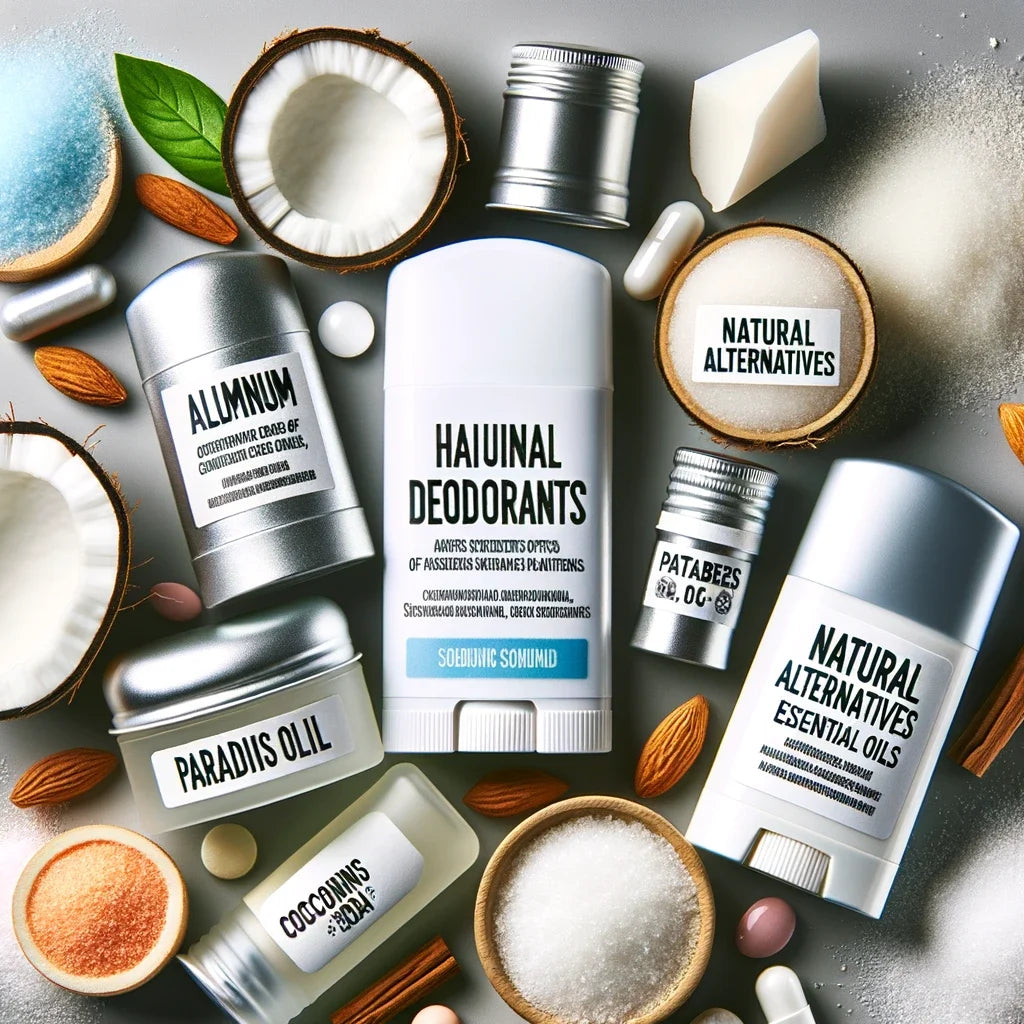Table of Contents
Health Risks of Conventional Deodorants
Conventional deodorants contain many chemicals that may cause skin irritation and other health issues. Some ingredients have been linked to serious health concerns, including cancer and endocrine disruptions.
Chemical Exposure and Skin Irritation
Many conventional deodorants contain chemicals that may cause skin irritation. Ingredients like parabens, phthalates, and triclosan are often used to preserve the product and kill bacteria.
These chemicals can be harsh on the skin and lead to redness, itching, and even allergic reactions. Synthetic fragrances can also cause contact dermatitis, a type of eczema that results in red, inflamed skin.
In particular, deodorants containing aluminum compounds such as aluminum chlorohydrate can clog pores, leading to underarm rashes and discomfort. Long-term use of these products may worsen symptoms of skin conditions like Acanthosis Nigricans, characterized by dark, thickened skin, often in the armpit area.
Link Between Deodorants and Cancer
Certain ingredients in deodorants are controversially linked to an increased risk of cancer. Aluminum compounds used in antiperspirants prevent sweating by forming a temporary plug within the sweat ducts.
Some research suggests these aluminum compounds may be absorbed by the skin and cause changes in estrogen receptors of breast cells, potentially increasing the risk of breast cancer.
Moreover, parabens are used as preservatives in many deodorants. They have weak estrogen-like properties that have raised concerns about their role in breast cancer. Although more research is needed, limiting exposure to such chemicals could be a prudent choice.
Endocrine Disruptors in Antiperspirants
Endocrine disruptors are chemicals that can interfere with our body's hormone systems. Deodorants often contain ingredients that may affect hormone balance.
Phthalates, commonly used to stabilize fragrance, may impact thyroid function and reproductive systems. Triclosan, another common ingredient, is believed to cause hormonal imbalances and impair thyroid function.
These potential risks are especially concerning for young girls and women because even low levels of endocrine disruptors can lead to serious health conditions over time. To minimize exposure, opting for natural or fragrance-free deodorants could be beneficial.
Effects of Deodorants on Sweat Glands and Body Odor

Deodorants influence both sweat glands and body odor. They can alter the skin’s microbiome and block sweat glands to reduce sweating and odors.
Interaction with Microbiome
Deodorants affect the microbiome in our armpits. They kill or reduce bacteria that cause bad body odor. These bacteria normally break down sweat into odorous compounds. When we use deodorants that contain alcohol or other antibacterial agents, they change this balance. This reduction in bacteria helps control odor temporarily.
However, over time, changes in the microbiome can lead to skin irritation or sensitivity for some people. Some deodorants contain chemicals like parabens and phthalates, which might affect hormone levels. Natural alternatives, free of harsh chemicals, are gaining popularity.
We should consider the type of deodorant we use, as it has a direct impact on our skin’s health and microbiome balance.
Blocking Sweat Glands
Antiperspirants, a type of deodorant, work by blocking sweat glands. They contain aluminum compounds that form a temporary plug in sweat ducts. This reduces the amount of sweat released, keeping the underarm area dry. Blocking sweat glands helps prevent moisture, which bacteria thrive on, hence reducing body odor.
But constant use can irritate sweat glands, causing discomfort or even swelling. Some research suggests a potential link between aluminum in antiperspirants and health risks like breast cancer, although this is not conclusively proven.
For those concerned about these risks, using aluminum-free deodorants might be a safer option. By understanding how these products interact with our body, we can make more informed personal care choices.
Alternative Options to Conventional Deodorants

Exploring alternatives to conventional deodorants can improve armpit health and mitigate risks related to harsh chemicals. Natural and aluminum-free options are often preferred due to their safer ingredients and skin benefits.
Benefits of Natural Deodorants
Natural deodorants often contain ingredients that are gentler on the skin. They typically avoid harsh chemicals like aluminum and propylene glycol, which can irritate the skin and exacerbate conditions like armpit discoloration.
Using natural ingredients such as coconut oil and essential oils can provide effective odor control without harmful side effects. Plant-based and mineral-based components can help balance the microbiome, enhancing the skin's natural defenses.
Probiotic deodorants introduce good bacteria that can outcompete the odor-causing bacteria. These alternatives not only mask the odor but help in reducing it altogether. Additionally, natural deodorants reduce the risk of clogging pores and allow the skin to breathe more freely.
Ingredients in Safer Deodorants
Safer deodorants often highlight ingredients known for their gentle and effective properties. Baking soda is a common ingredient due to its natural odor-neutralizing abilities. Though effective, it must be balanced with other soothing ingredients to prevent irritation in sensitive skin.
Coconut oil is frequently used for its moisturizing properties. It helps in calming irritated skin and adds a layer of protection and hydration. Magnesium offers a mineral-based solution for controlling moisture and maintaining a healthy skin barrier without blocking sweat ducts as aluminum does.
Essential oils like lavender and tea tree not only provide pleasant scents but also possess antibacterial properties. Plant-based and probiotic components can further ensure that the product supports healthy skin flora while effectively managing odor.
For those avoiding traditional deodorants, these alternative options provide viable solutions, combining efficacy with safety in their formulations, benefitting both skin health and overall well-being.
Regulatory Aspects and Safety Standards

Understanding the regulatory aspects and safety standards of deodorants is crucial for consumers, especially those dealing with conditions like armpit discoloration. This section will explore the positions of the American Cancer Society and the FDA evaluation on deodorant ingredients to provide a clear picture of their safety.
American Cancer Society's Stance
The American Cancer Society (ACS) monitors potential health risks related to personal care products, including deodorants. They emphasize that while there is some public concern regarding deodorants and cancer, current scientific evidence does not support a direct link between deodorants and cancer. According to the ACS, the risk of harmful effects is mitigated by stringent safety evaluations and regulations.
The ACS also tracks ongoing research and ensures that new findings are considered to keep consumers informed. Their stance encourages the use of deodorants with ingredients that are tested and deemed safe. This focus on continuous evaluation ensures that deodorants used by the public do not pose significant health risks.
FDA Evaluation of Deodorant Ingredients
The Food and Drug Administration (FDA) plays a critical role in evaluating the ingredients used in deodorants. Unlike drugs, deodorants are classified as cosmetics and face different regulatory standards. The FDA ensures that the ingredients in deodorants are safe for consumer use through rigorous testing and assessment protocols.
Deodorants on the market must not contain harmful substances or exceed safety limits for certain chemicals. For instance, the FDA closely examines the use of aluminum compounds often found in antiperspirants and their potential links to health issues. The FDA's evaluation process includes reviewing scientific data and monitoring any adverse reactions reported by consumers. This rigorous oversight helps protect users from potential health hazards.
By relying on the insights and regulations from both the ACS and the FDA, we can make informed choices about the deodorants we use, ensuring they are safe for our health.
Consumer Awareness and Responsible Usage
Being aware of what ingredients are in your deodorant and learning about safe usage can help you avoid health problems like allergic reactions and skin irritation.
Reading and Understanding Product Labels
It is crucial to read and understand product labels. Many deodorants contain preservatives like parabens. These chemicals might affect our hormones.
Look for fragrances and perfumes. They can irritate sensitive skin and cause allergies. Be cautious with ingredients like diethanolamine, which may be harmful.
Avoid deodorants with isobutane and propane. These are often used as propellants but can be harmful if inhaled.
The Role of Environmental Working Group
The Environmental Working Group (EWG) helps us identify safe products.
They rate products based on their ingredients and potential harm. This makes it easier to choose safer deodorants.
For example, they flag products with harmful plastics or preservatives. If we check their ratings, we can make better choices for our health.
Using EWG's resources can help us recognize products less likely to cause allergic reactions or contribute to armpit discoloration.
Frequently Asked Questions

Deodorants can contain harmful substances that may affect our health, particularly for those with sensitive skin or conditions like armpit discoloration. It's important to understand which ingredients to avoid and how to choose safer alternatives.
Which deodorants are linked to health risks?
Deodorants containing aluminum compounds, parabens, and phthalates are often linked to potential health risks. Aluminum can block sweat ducts, while parabens and phthalates have been associated with hormonal changes. For instance, spray deodorants have raised concerns in daily health risk assessments due to frequent use.
What are the indicators of a harmful deodorant?
Indicators of harmful deodorants include irritation, redness, and itchiness. Additionally, products with strong fragrances can indicate the presence of harmful chemicals. Frequent adverse reactions in users can signal that a deodorant may not be safe.
How can I identify toxic ingredients in deodorants?
To identify toxic ingredients in deodorants, look for aluminum, parabens, triclosan, and synthetic fragrances on the label. These substances can be harmful when absorbed through the skin. Use resources like the Environmental Working Group (EWG) database to check the safety of products.
Are there any deodorants known to cause adverse reactions?
Yes, some deodorants can cause adverse reactions such as allergic contact dermatitis. Products with high levels of fragrance or alcohol are common culprits. Studies reported in environmental health journals found that some people are more sensitive to these ingredients.
What should I look for in a safe and healthy deodorant?
A safe and healthy deodorant should be free from harmful chemicals like aluminum, parabens, and synthetic fragrances. Look for products with natural ingredients such as baking soda, coconut oil, or essential oils. These alternatives are less likely to cause skin irritation and other health issues.
Is it safe to use conventional deodorants daily?
Using conventional deodorants daily may expose you to harmful ingredients over time. While occasional use might not be harmful for everyone, those with sensitive skin or pre-existing conditions like armpit discoloration should be cautious. Opt for natural deodorants that limit exposure to potentially toxic substances.

